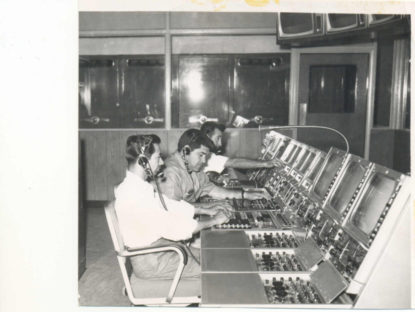Whether you’re talking about a flood, hurricane, snow storm, fire, or big earthquake, the same basic principles apply.
Don’t depend on being able to drive. Roads can easily jam when everyone is evacuating simultaneously. Not a good time to take that drive to a remote transmitter site for some unfinished chore.
Don’t depend on cell phones. Most sites have backup power, but they can depend on good fiber feeds and be easily overwhelmed by unusual usage, and battery backup on some fiber feeds may go out after several hours. If you must communicate, SMS text traffic can often get through when voice traffic cannot.
Maintain your analog radio communications systems. Your station should have charged handi-talkies available for emergency use, says KGTV’s Andrew Lombard, and if you still have mobile 2-way units, they can be life-savers during emergencies or even for conventional communications to distant sites. “If you don’t have a two-way 450mHz band radio system, get one. Buy it. Lease it. Borrow it. [Then,] keep your 2-way radio system in good running condition!”
Your POTS line may not work in an outage. The old days of battery-floated telephone lines are fading in favor of voice-over-IP systems often delivered by cable companies. Even AT&T delivers phone service over both fiber and copper pairs now.
Test often. Backup generators must be exercised regularly, although your pollution control district can severely limit your opportunities to test diesel units.
Consider solar backup. With creative design, modern equipment and low-power lighting, you may be able to operate indefinitely with solar panels, prioritized power management, and storage batteries. It’s expensive upfront, but you aren’t subject to pollution rules and you will eventually pay for the system with power bill savings. There are numerous companies out there who can finance the costs with your energy savings, but you need a supportive management willing to accept a 15 – 20-year ROI.
Manage your batteries. Says Lombard, “Keep all your batteries charged, have an inverter in your car for battery charging, keep a set of jumper cables in your vehicle, and keep a working 12V battery-powered spotlight in the vehicle.” Rechargeable batteries in infrequently used devices like broadcast radios or flashlights should be the newer lithium-ion (Li-Ion) polymer or low self-discharge nickel-metal hydride (NiMH) batteries. The latter are sold under the trade names Sanyo Eneloop, Tenergy Centura, Ultralast Hybrio, Maha Imedion, Energizer Recharge, RayOVac Hybrid, and Duracell Rechargeable Pre-Charged
Keep emergency food rations. This one may not be so obvious to those in better weather climates, but there are going to be times when stores can’t operate. Reminds Lombard, “Keep emergency supplies stored somewhere–but not in vehicles–and send them with crews when they go out on a breaking story that will take a long time or have someone available to run supplies out to field crews.” Emergency water supplies are always there if your station buys water in large jugs, but filters can work if you have a known source of fresh water.
Don’t depend on fiber or two-wire copper links. In San Diego, some continued working and some didn’t. If a line uses a battery float, it may maintain power for a limited time. Operation of leased lines has become especially difficult to predict.
Consider auxiliary sites. Especially if you already own or lease an alternative site, putting up a small FM transmitter can be relatively cheap way to stay on the air with huge redundancy value. The payoff for TV and AM can be diminished since few watch TV over-the-air now and AM usually requires expensive antenna engineering.
Communicate with management regarding your capabilities. This issue deserves an article itself. What is your return on investment with backup power and/or an auxiliary broadcast site? Are you protecting your reputation with your listeners or viewers? Are you an emergency primary station? Are you willing to study pollution laws if running a generator? If you are considering solar and batteries as an alternative, how much will it cost you to partition your power load to run off-the-grid for an indefinite period? At the time of an outage, your general manager and corporate engineering managers must not be surprised by your preparedness level or your job may be on the line. If you have sufficiently informed them of a lack of funds for backup equipment, then they shouldn’t be surprised by your outage. On the other hand, if you were given sufficient money, your equipment should always be ready for operation.


